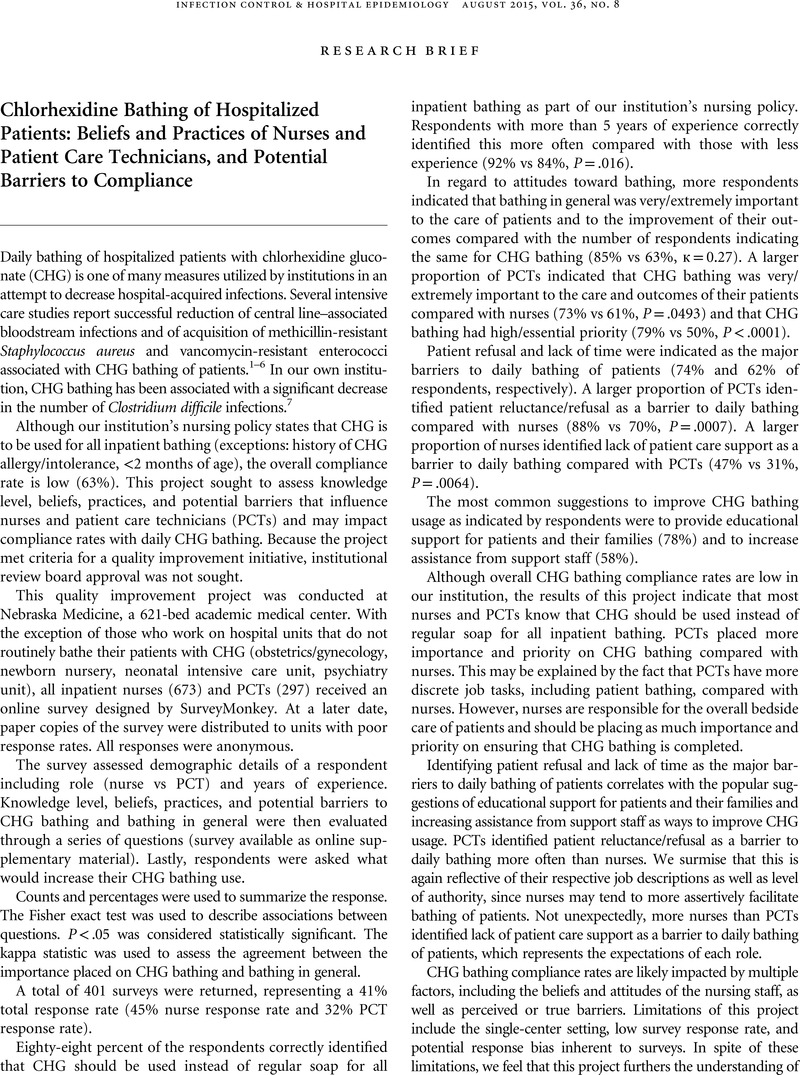Crossref Citations
This article has been cited by the following publications. This list is generated based on data provided by Crossref.
Bridges, Elizabeth
McNeill, Margaret
and
Munro, Nancy
2016.
Research in Review: Driving Critical Care Practice Change.
American Journal of Critical Care,
Vol. 25,
Issue. 1,
p.
76.
Abbas, Salma
and
Sastry, Sangeeta
2016.
Chlorhexidine: Patient Bathing and Infection Prevention.
Current Infectious Disease Reports,
Vol. 18,
Issue. 8,
Denny, Janette
and
Munro, Cindy L.
2017.
Chlorhexidine Bathing Effects on Health-Care-Associated Infections.
Biological Research For Nursing,
Vol. 19,
Issue. 2,
p.
123.
Musuuza, Jackson S.
Roberts, Tonya J.
Carayon, Pascale
and
Safdar, Nasia
2017.
Assessing the sustainability of daily chlorhexidine bathing in the intensive care unit of a Veteran’s Hospital by examining nurses’ perspectives and experiences.
BMC Infectious Diseases,
Vol. 17,
Issue. 1,
Hickey, Victoria
Flesch, Laura
Lane, Adam
Pai, Ahna L.H.
Huber, John
Badia, Priscila
Davies, Stella M.
and
Dandoy, Christopher E.
2018.
Token economy to improve adherence to activities of daily living.
Pediatric Blood & Cancer,
Vol. 65,
Issue. 11,
Caya, Teresa
Knobloch, Mary Jo
Musuuza, Jackson
Wilhelmson, Emily
and
Safdar, Nasia
2019.
Patient perceptions of chlorhexidine bathing: A pilot study using the health belief model.
American Journal of Infection Control,
Vol. 47,
Issue. 1,
p.
18.
Musuuza, Jackson S.
Guru, Pramod K.
O’Horo, John C.
Bongiorno, Connie M.
Korobkin, Marc A.
Gangnon, Ronald E.
and
Safdar, Nasia
2019.
The impact of chlorhexidine bathing on hospital-acquired bloodstream infections: a systematic review and meta-analysis.
BMC Infectious Diseases,
Vol. 19,
Issue. 1,
Reynolds, Staci Sue
Sova, Chris
McNalty, Bridget
Lambert, Suzanne
and
Granger, Bradi
2019.
Implementation Strategies to Improve Evidence-Based Bathing Practices in a Neuro ICU.
Journal of Nursing Care Quality,
Vol. 34,
Issue. 2,
p.
133.
Reynolds, Staci S.
Woltz, Patricia
Keating, Edward
Neff, Janice
Elliott, Jennifer
Hatch, Daniel
Yang, Qing
and
Granger, Bradi B.
2021.
Results of the CHlorhexidine Gluconate Bathing implementation intervention to improve evidence-based nursing practices for prevention of central line associated bloodstream infections Study (CHanGing BathS): a stepped wedge cluster randomized trial.
Implementation Science,
Vol. 16,
Issue. 1,
Knobloch, Mary Jo
Musuuza, Jackson S.
McKinley, Linda
Zimbric, Michele L.
Baubie, Kelsey
Hundt, Ann Schoofs
Carayon, Pascale
Hagle, Mary
Pfeiffer, Christopher D.
Galea, Marinella D.
Crnich, Christopher J
and
Safdar, Nasia
2021.
Implementing daily chlorhexidine gluconate (CHG) bathing in VA settings: The human factors engineering to prevent resistant organisms (HERO) project.
American Journal of Infection Control,
Vol. 49,
Issue. 6,
p.
775.
Destine, Yvette
Capes, Kellie
and
Reynolds, Staci S.
2023.
Reduction in patient refusal of CHG bathing.
American Journal of Infection Control,
Vol. 51,
Issue. 9,
p.
1034.
Harrington, Elaine M.
Trautman, Kathryn
Davis, Mary B.
Varzavand, Kristin
Meacham, Holly
Dains, Angelique
Marra, Alexandre R.
McDanel, Jennifer
Kenne, Lynnette
Hanna, Beth
Murphy, Jaime P.
Diekema, Daniel J.
Wellington, Melanie
Brust, Karen B.
Kobayashi, Takaaki
and
Abosi, Oluchi J.
2024.
Descriptive epidemiology of central line-associated bloodstream infections at an academic medical center in Iowa, 2019-2022.
American Journal of Infection Control,
Vol. 52,
Issue. 4,
p.
436.



